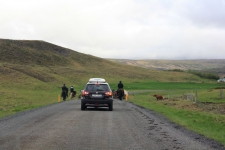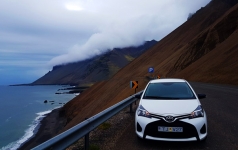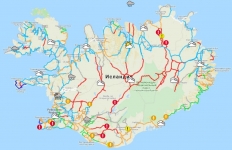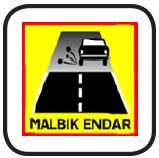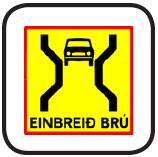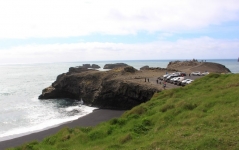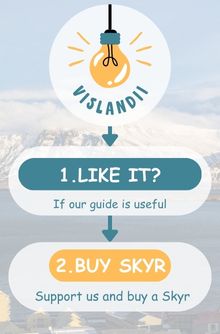Iceland seems to be created for car tourism, and you can drive a jeep to any point where a dirt "path" leads. The most interesting thing in terms of driving is the center of the island (Highland). And at the same time, for those who want to practice off-road, there are no restrictions on visiting any parts of the island. There are no paid zones, paid attractions and paid parking near attractions anywhere (although recently they have begun to appear near the most famous attractions).
Content:
- Road designations in Iceland
- F - roads of Iceland
- Road safety in Iceland
- Top 12 tips on the roads in Iceland
- Opening time of mountain roads in spring
The length of Iceland's highway network is 12,890 km. Of these, only 4,782 km are covered with asphalt, the rest is primed.
But do not be afraid, these are still Icelandic primers - an almost perfectly smooth surface, without holes and bumps. All dirt roads are regularly leveled by graders.
Road designations in Iceland
Roads belonging to the national highway system run by the Icelandic Road Industry. They are categorized as follows:
- S — Main Roads – Road #1, which connects Reykjavik with Reykjavik, bypassing the entire island in a circle
- T — Secondary roads – tengivegi in translation – country roads (usually a two-digit number), usually more than 10 kilometers long
- H – Local roads that provide access to private farms and do not correspond to the quality of tengivegi (usually a three-digit number)
- L is a road that does not belong to any of the above categories
- F – unpaved roads where only 4x4 is allowed. A lot of them with elements of river crossing fording
10 rules for a great car ride in Iceland!
One of the best, and sometimes the only, ways to get to know Iceland intimately is by car. Or rather, a trip by car. The most popular route for independent travel in I...
F - roads of Iceland
As mentioned above, F-roads are unpaved roads that, according to the rules of Iceland, can only be entered by a full-drive car.
Roads F with two—digit numbers are better - there may be smooth gravel without extreme (Primary highland road).
F roads with three—digit numbers are much more difficult in terms of terrain and coverage.
Lovers of a more relaxing holiday are attracted by the sights in a relatively comfortable area on Ring Road No. 1 (Primary road). And for fans of a real jeep trip outside the main road, the Icelandic Highland is suitable, that's where the fun begins. First, a short trip along a secondary road, and then the F-road begins. But these roads can be treacherous as much as they are interesting. So it's worth being more careful here.
Off-road driving is prohibited in Iceland. That is, you can drive along the designated dirt road for 4x4, but you should not move off it in any case! The reason is that Iceland's nature is unique, but very fragile, and it can take years to restore the "minimal" damage, and some damage will not recover at all. On the Lakagígar Road (F206) The slopes adjacent to the road consist of fine volcanic ash, on which moss grows, the same legendary moss, which is bright green after prolonged rains. So these slopes have been traveled by fans of off-road and, unfortunately, the moss in these places will not recover very soon.
When you rent a car in Iceland, it is worth considering which part of the island you are going to go to and what roads there are. Also, some roads may be closed during the "off-season" because they are not cleared of snow and are not passable. In early summer, high-altitude roads may also be closed due to the fact that the snow has not yet melted. It is impossible to determine the exact dates of the opening of such roads, but you can see the statistics for the last 5 years.
According to the terms of many car rental companies in Iceland, if the car is not four-wheel drive, then it is not allowed to drive on type F roads. But if you did go there and something happened, then this is not considered an insured event, and you will cover all the damage at your own expense. Therefore, it is important to think over your route in advance and not try to conquer off-road terrain on a rental sedan. If you don't have experience driving on mountain roads, you shouldn't go there either.
Car rental in Iceland - tips and tricks
Rent a car in Iceland - how to choose proper car, what is the cost of renting a car, is it worth taking full insurance, where you can drive a car, and where you have t...
Road safety in Iceland
A few statistics - in total, Iceland has 13 thousand kilometers of roads, only 2.5 of which are F-roads.
No special training is required to travel on F-roads, even three-digit ones, but you need to master basic skills confidently. A good jeep, good rubber and an extra canister of fuel are enough.
The scariest thing that can occur on these roads is: fords (during the warm season, when glaciers melt, some rivers can be quite full-flowing), sharp stones, lack of gas stations.
The soil is stable enough, so the probability of getting stuck in "quicksand" is low. If you are not sure whether to ford the river, wait for another car, look at the depth and route of the ford and ask another driver to wait in case you need help.
Smartphone owners can feel more secure, as the Iceland Rescue Service (ICE-SAR) has announced the launch of the 112 Iceland (SOS Iceland) program for tourists. The program allows you to both inform that help is needed, and regularly inform about your location, which, if necessary, facilitates the provision of assistance. The program works steadily not only in networks with a fast connection. A regular GSM connection is quite enough for work. You can download the program through the iPhone App Store and Google's Play Store for Android devices.
Iceland's road map and attractions: Travel safely
Traveling in Iceland is becoming more and more popular every year. Many tourists choose to travel by car, some choose multi-day hikes, but it is clear that few stay in...
To check the current traffic situation in Iceland (which roads are closed or open, the weather, and so on) you can use the page:
http://www.road.is/travel-info/road-conditions-and-weather/entire-iceland-road-conditions-map/
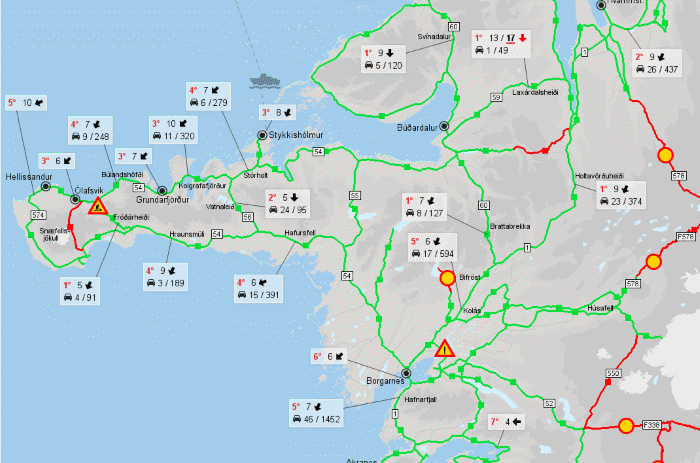
Top 11 tips on the roads in Iceland
- All passengers are required to wear seat belts at all times. This also applies to the rear seats, as they are no safer than the front seats. The driver will be obliged to pay a fine for passengers who are not wearing seat belts.
- Don't stop on the road or on the side of the road for photos. Many accidents happen when foreign tourists stop in an unsafe place to admire the view or take pictures. On Icelandic roads, there are always pockets in the most interesting places so that you can stop safely.
- Choose your speed according to the conditions... weather and roads. The speed limit on road signs is applicable in good conditions, and in winter conditions, conditions are rarely good enough. Measure the speed according to the conditions.
- Slow down as you approach gravel roads. Tires lose their grip when moving from paved roads to gravel. Not slowing down can cause you to lose control of the car.
- If you see a sign that the road is closed, you should not go for your own safety. "Lokað" means closed. Icelanders don't close roads unless they have to.
- The headlights on the car must be turned on all the time - all year round. The "auto" setting for the light is not enough.
- Check the weather and road conditions before you start driving. This is especially important in winter.
- Stop for oncoming traffic on single-lane bridges.The speed limit is 50 km/h, and the car that arrived first has the right of way. Slow down as you approach single-lane bridges.
- Do not use your phone or tablet while driving. Be safe, pay attention to driving. Otherwise, you will receive heavy fines.
- Don't drive when you're tired. Change drivers, stop from time to time to rest for 15 minutes and don't plan long days.
- Children under 135 cm are legally required to use car seats. The car seat should be suitable for their age.
Opening time of mountain roads in spring
If you are going to travel by car in Iceland, you need to check if the road is open. You can do this on the website:
http://www.road.is/travel-info/condition-and-opening-of-mountain-roads/
Approximate dates of the opening of mountain roads in Iceland:
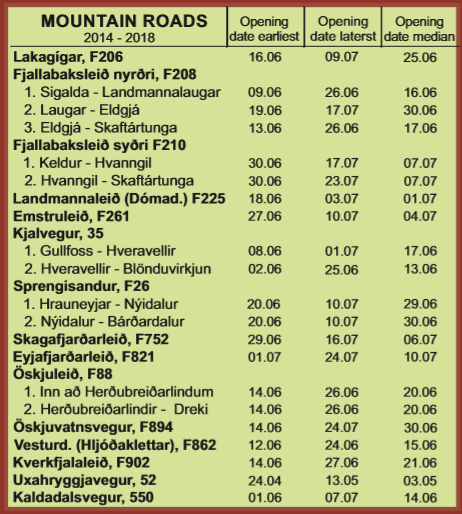
How to rent a car in Iceland, step-by-step instructions
People who travel to Iceland often have a question - How do I rent a car? Where can I find good car rental companies, where is the best place to pick up a car and, in ...

